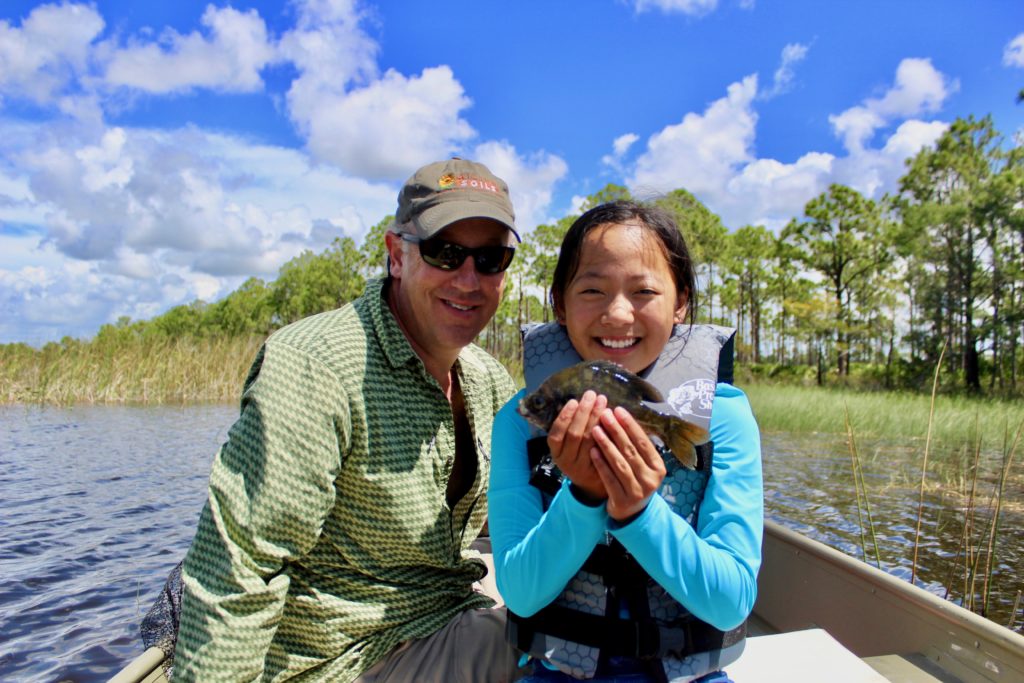Fishing resources and tips for the empowered female angler.
9 Things to Remember When Taking a Kid Fishing
July 9, 2015

Every time I’m out on the water, I think of how grateful I am that my grandfather shared his passion for fishing and the outdoors with me when I was young. Now that I’m an adult, the best way I know to “pay it forward” is by taking a kid fishing whenever I can. However, there are a few important tips you should keep in mind to help ensure that the experience is enjoyable, safe and memorable for all involved.
- Use the right type of equipment. Buy a rod and reel that has been made specifically for kids. Adult-size rods and reels can be difficult for kids to use, so find a rod and reel that will fit the child’s grip. Shorter rods (four to five feet in length), and smaller spin-cast reels are usually much easier for kids to handle. Rig the rod and reel with 8 lb monofilament fishing line and a small fishing hook (Mustad baitholder hooks in sizes from 6 to 2/0 are good to have on hand for a variety of live and natural baits). This type of tackle set up will work well with a live cricket or an earthworm when targeting panfish. Last, but not least, don’t forget to bring along a red and white plastic bobber. The child can have fun watching the bobber bounce up and down when he or she gets a bite.
- Practice casting in an open field or yard using a casting plug beforehand. Plastic or rubber casting plugs are often included with most rod and reel combos. The practice casting plugs don’t have hooks and work great in an empty field or open backyard area. A little practice can make a big difference when it comes time to cast into a lake or pond.
- Bring along drinking water, a hat, sunglasses, insect repellent and sunscreen for the child and for yourself. Make sure everyone is hydrated, comfortable and protected from the elements. Having a few healthy, non-perishable fishing snacks along is always a good idea as well.
- Make sure that the child is wearing a youth life jacket that fits properly. First, check the manufacturer’s label to be sure that the life jacket is U.S. Coast Guard approved, and is a proper fit for the child’s size and weight. Then, make sure the jacket is properly fastened, make sure there is no excess room above the openings, and that the jacket does not ride up over the child’s chin or face.
- Don’t plan to fish for too long. An hour or two is enough if it’s the child’s very first time. Kids have a hard time sitting still for too long, and may get bored easily. If you can, point out and teach them the names of different species of birds or baitfish in between bites. Get the child interested in the overall experience of being outdoors. Just seeing other people outdoors and enjoying time on the water will inspire curiosity in young children.
- Go to a spot where you know there is a high likelihood that you’ll catch fish. When taking a kid fishing for the first time, find a location that has shoreline access and plenty of fish. Panfish, such as bluegill or crappie, are ideal for young children. These species are usually accessible right along the weeds or shorelines. Don’t worry about the size of the catch — catching fish of any size is the key to keeping kids entertained. Focus on easy to catch species that provide plenty of action.
- Use live or natural baits. An earthworm is probably the best freshwater bait when taking a kid fishing for the first time. Worms are easy to put on a hook (half of the worm will work just fine for panfish), and you can dig them up right out of your garden or buy them at a bait shop. Minnows and crickets will also work well.
- Bait the child’s hook for them on the first trip. Adults should always bait the child’s hook for them on the first trip or at least until the child understands how to exercise caution when handling sharp fishing hooks. Always supervise children very carefully when allowing them to bait hooks. To be extra cautious, you can also purchase barbless hooks or pinch down the barb.
- Teach kids proper fish handling for catch and release. Let kids know why it’s important to minimize the length of time the fish is out of water. Gently remove the hook while holding the fish with bare hands (no towels), and give the child a quick opportunity to admire the fish before you release it. Parents and fishing mentors should always read the state fishing regulations in advance of each trip to be sure that they know the current fishing regulations and licensing requirements.
Have you “paid it forward” by taking a kid fishing lately? If so, I’d love for you to share your fishing photos on the Shefishes2 Facebook Page or by “tweeting” me up on Twitter @shefishes2.